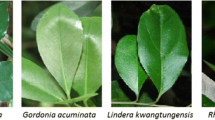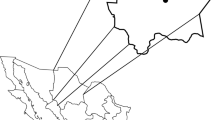Abstract
A multiple-regression model is presented for estimating the effect of major air pollutants on net photosynthetic rate (Pn) ofQuercus mongolica leaves, of which visible injury is not shown. Photosynthetic capacity was found to be primarily a function of PPFD, air temperature (T) and ambient ozone (O3) concentration. The negative direction of photosynthetic capacity response to O3 concentration indicates a potential growth reduction ofQ. mongolica due to ambient O3 concentration in the urban areas of Korea. The model was compared with a non-linear regression model including the same variables. We assessed the contribution of variables to two two models of ambient O3 affecting Pn ofQ. mongolica leaves. The mean Pn difference between the models with and without ambient O3 in the multiple-regression was smaller than that in the non-linear regression. The relative contributions of ambient O3 to multiple-regression and non-linear regression were 12.6% and 5.6%, respectively. The results indicate that multiple-regression models can be applicable for qualitative or quantitative assessment of the effect of air pollutants on Pn response of plant leaves, of which visible injury may not be shown in situ. Also, the assessment of ecophysiological effects using numerical models will have a degree of uncertainty associated with the measuring time/period of the field data used in the modelling, as well as the numerical structure of the models.
Similar content being viewed by others
Literature Cited
Brault S, Caswell H (1993) Pod-specific demography of killer-whales (Orcinus orca). Ecology74: 1444–1454
Cook ER, Johnson A (1989) Climate change and forest decline: A review of the red spruce case. Water Air and Soil Pollut48: 127–140
Efron B (1987) Better bootstrap confidence intervals (with discussion). J Amer Stat Assoc82: 171–200
Heck WW, Adams RM, Cure W, Heagle AS, Heggestad HE, Kohut RJ, Kress LW, Rawlings JO, Taylor OC (1983) A reassessment of crop loss from ozone II. Environ Sci Technol17: 572A-581A
Heck WW, Cure W, Rawlings JO, Zaragosa LF, Heagle AS, Heggestad ME, Kohut RJ, Kress LW, Temple PJ (1984a) Assessing impacts of ozone on agricultural crops. I. Overview, J Air Pollut Control Assoc34: 729–735
Heck WW, Cure W, Rawlings JO, Zaragosa LF, Heagle AS, Heggestad HE, Kohut RJ, Kress LW, Temple PJ (1984b) Assessing impacts of ozone on agricultural crops. II. Crop yield functions and alternative exposure statistics. J Air Pollut Concrol Assoc34: 810–817
Heck WW, Taylor OC, Adams R, Bingham G, Miller J, Pleston E, Weinstein L (1982) Assessment of crop losses from ozone. J Air Pollut Control Assoc32: 353–361
Hinlichsen D (1987) The stands decline enigma: What underlies xtensive dieback on two continents? Bio-Science37: 542–544C
Hocking RR (1976) The analysis and selection of variables in linear regression. Biometrics32: 1–51
Hoerl AE, Kennard RW (1970) Ridge regression: biased estimation for non-orthogonal problems. Technometrics12: 55–61
Hong S-K, Nakagoshi N (1998) Comparison of the initial demographies of pine and oak populations in rural pine forests in Korea and Japan. J Plant Biol41: 208–218
Kim JW, Kim J-H (1995) Responses in net photosynthetic rate ofQuercus mongolica leaves to ozone. Korean J Ecol18: 265–273
Kim JW, Kim J-H (1997) Modelling the net photosynthetic rate ofQuercus mongolica stands affected by ambient ozone. Ecol Model97: 167–177
Krupa SV, Grunhage L, Jager H-J, Nosal M, Manning WJ, Legge AH, Hanewald K (1995) Ambient ozone (O3) adverse crop response: a unified view of cause and effect. Environ Pollut87: 119–126
Krupa SV, Kickert RN (1987) An analysis of numerical models of air-pollutant exposure and vegetation response. Environ Pollut44: 127–158
Larson Rl, Heck WW (1976) An air quality data analysis system for interrelating effects, standards and needed source reductions. Part 3. Vegetation injury. J Air Pollut Control Assoc26: 325–333
Long SP,Hallgren J-E (1985) Measurement of CO2 assimilation by plants in the field and the laboratory.In J Coombs, DO Hall, SP Long, JMO Scurlock, eds, Techniques in Bioproductivity and Photosynthesis, Ed 2. Pergamon Press, pp 62–94
Manly BFJ (1990) On the statistical analysis of niche data. Can J 200168: 1420–1422
Meldahl RS, Chappelka AH, Lockaby BG (1992) Use of a non-linear model in examining growth responses of loblolly pine to ozone and acid precipitation. Atmos Environ Part A-General topics26: 279–286
Meyers RH (1990) Classical and Modern Regression With Applications. PWS-KENT Publishing Company, Boston
Miller PR (1989) Concept of forest decline in relation to western U.S. forests.In JJ MacKenzie, MT El-Ashry, eds, Air Pollutions Toll on Forests and Crops, Yale University Pless, New Haven and London, pp 75–112
Mohren GMJ, Jorritsma ITM, Vermetten AWM, Kropff MJ, Smeets WLM, Tikak A (1992) Quantifying the direct effects of SO2 and O. on stands growth. For Ecol Manage51: 137–150
Moldau H, Suber J, Karolin A, Kallis A (1991) CO2 uptake and respiration losses in vegetative bean plants due to ozone absorption. Photosynthetica25: 341–349
Mueller LD (1979) A comparison of two methods for making statistical inferences on Nei’s measure of genetic distance. Biometrics35: 757–763
Potvin C, Roff DA (1993) Distribution-free and robust statistical methods: Viable alternatives to parametric statistics? Ecology74: 1617–1628
Prinz B, Brandt CJ (1985) Effects of air pollution on vegetation.In HW Nornberg, eds, Pollutants and Their Ecotoxicological Significance, John & Sons Ltd, New York, pp 67–84
Prinz B (1987) Major hypotheses and factors: Causes of forest damage in Europe. Environment29: 11–15
Reich PB, Ellsworth DS, Kloeppel BD, Fownes JH, Gower ST (1990) Vertical variation in canopy structure and CO2, exchange of oak-maple stands: Influence of ozone, nitrogen, and other factors on simulated canopy carbon gain. Iree Physiol7: 329–45
Reich PB, Lassoie JP (1985) Influence of low concentrations of ozone on growth, biomass partitioning and leaf senescence in young hybrid poplar plants. Fnviron Pollui SerA33: 59–51
Reich PB, Amuncison RG (1984) Low level O3 and/or SO2 exposure cause’s a linear dec line in soybean yield. Fnviron Pollut Ser A34: 545–355
Reich PB, Amundson RG (1985) Ambient levels of ozone reduce net photosynthesis in tree crop species. Science1230: 566–570
Rhyu TC, Kim J-H (1994a) Growth response to acid rain, Mg deficiency and Al surplus, and amelioration of Al toxicity by humic substances in pile h pine seedlings. J Plant Biol37: 301–308
Rhyu TC, Kim J-H (1994b) Water deficit of pitch pines caused by superficial rooting and air pollutants in Seoul and its vicinity. J Plant Biol37: 309–316
SAS (1930) SAS Users Guide, Statistics, Version 6. SAS Institute, Inc., Gary, NC
Shapiro SS, Wilk MB (1965) An analysis of variance test for normalitv (complete samples). Biometrika52: 591–611
Smith EP (1985) Lslimating tine reliability of diet overlap measures. Inviron Biol fishes13: 125–58
Smith EP, Genter RB, Cairns J (1986) Confidence intervals tor the similarity between algal communities. Hydrobiologia139: 237–245
Tomlinson IIGH (1985) Air pollutants and forest decline. Environ Sc Technol17: 246A-55A
Yang Y-S, Skelly JM, Chevone Bl, Bilch JB (1983) Fffects of long-term ozone exposure on photosynthesis and dark respiration of eastern white pine. Fnviron Sci Tec hnol17:171–173
Author information
Authors and Affiliations
Corresponding author
Rights and permissions
About this article
Cite this article
Kim, JH., Ihm, B.S. & Kim, J.W. Comparison of two numerical models on photosynthetic response ofQuercus mongolica leaves to air pollutants. J. Plant Biol. 42, 32–40 (1999). https://doi.org/10.1007/BF03031144
Received:
Accepted:
Issue Date:
DOI: https://doi.org/10.1007/BF03031144




